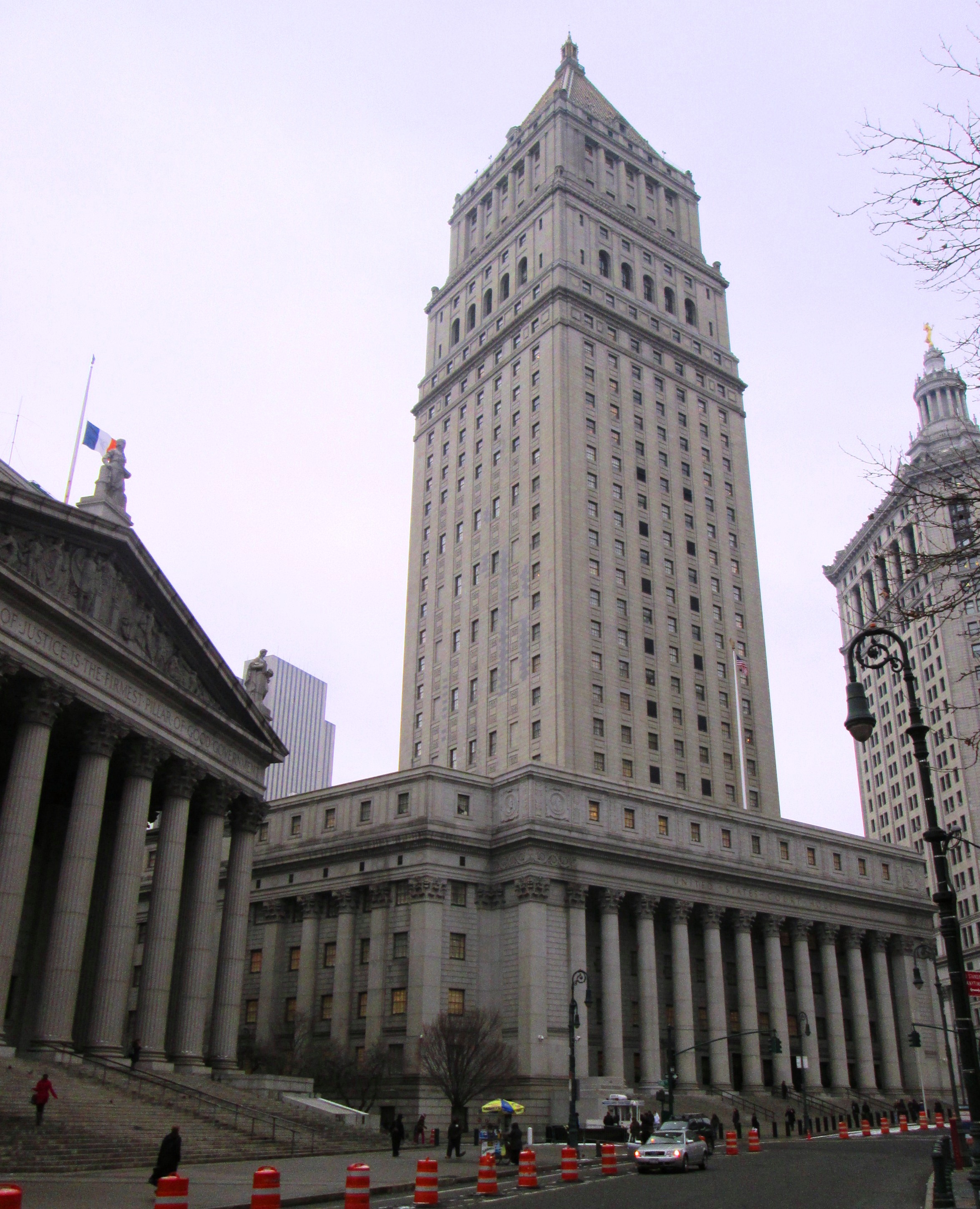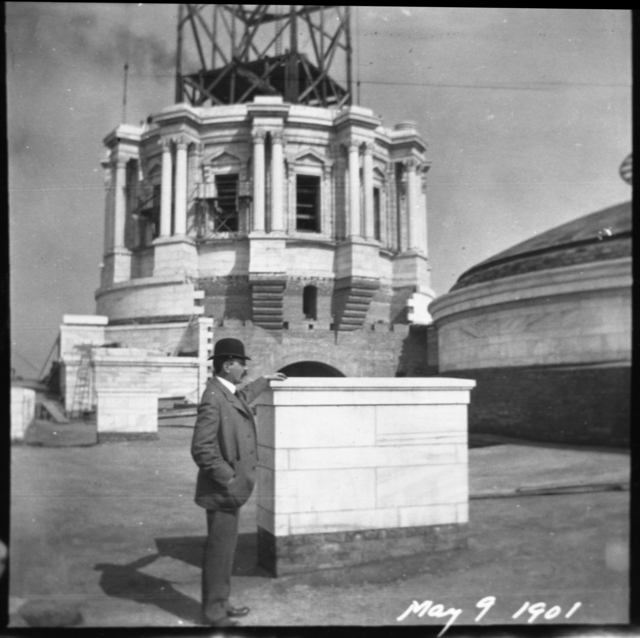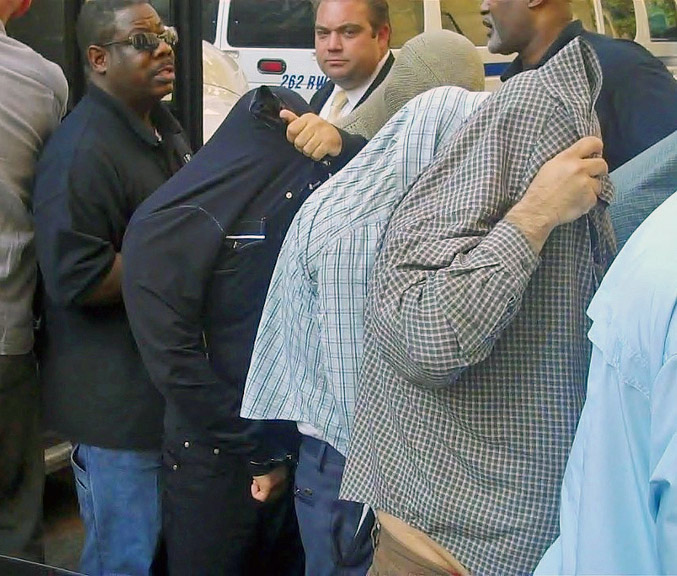|
60 Centre Street
The New York State Supreme Court Building, originally known as the New York County Courthouse, at 60 Centre Street on Foley Square in the Civic Center neighborhood of Manhattan, New York City, houses the Civil and Appellate Terms of the New York State Supreme Court for the state's First Judicial District, which is coextensive with Manhattan, as well as the offices of the New York County Clerk. The granite-faced hexagonal building was designed by Guy Lowell of Boston in classical Roman style and was built between 1913 and 1927, completion having been delayed by World War I. It replaced the former New York County Courthouse on Chambers Street, popularly known as the Tweed Courthouse. Both the interior and exterior are New York City Landmarks: the exterior was designated on February 1, 1966 and the interior on March 24, 1981. Site The building is somewhat of an older sibling to Cass Gilbert's 1936 Corinthian-columned Foley Square Courthouse (renamed the Thurgood Marshall United ... [...More Info...] [...Related Items...] OR: [Wikipedia] [Google] [Baidu] |
Centre Street (Manhattan)
Centre Street is a north–south street in the New York City borough of Manhattan, running through the Civic Center, Chinatown (曼哈頓華埠), and Little Italy neighborhoods of Lower Manhattan. It connects Park Row to the south with Spring Street to the north, where it merges with Lafayette Street. Centre Street carries northbound traffic north of Reade Street and two-way traffic between Reade Street and the Brooklyn Bridge. As late as 1821, there was no Centre Street. The area was previously occupied by the Collect Pond, a body of fresh water that was the nascent city's primary supply of drinking water, covering approximately and running as deep as . The pond was located just north of today's Foley Square and just west of modern Chinatown. It had been drained and the new street grid built over it a decade earlier. However, there was no street built between Pearl and Reade Streets. Cross Street (which came over from the nearby area that would several years later be dubbe ... [...More Info...] [...Related Items...] OR: [Wikipedia] [Google] [Baidu] |
Cass Gilbert
Cass Gilbert (November 24, 1859 – May 17, 1934) was an American architect. An early proponent of skyscrapers, his works include the Woolworth Building, the United States Supreme Court building, the state capitols of Minnesota, Arkansas and West Virginia; and the Detroit Public Library, the Saint Louis Art Museum and Public Library. His public buildings in the Beaux Arts style reflect the optimistic American sense that the nation was heir to Greek democracy, Roman law and Renaissance humanism. Gilbert's achievements were recognized in his lifetime; he served as president of the American Institute of Architects in 1908–09. Gilbert was a conservative who believed architecture should reflect historic traditions and the established social order. His design of the new Supreme Court building (1935), with its classical lines and small size, contrasted sharply with the large federal buildings going up along the National Mall in Washington, D.C., which he disliked. Heilbrun says "G ... [...More Info...] [...Related Items...] OR: [Wikipedia] [Google] [Baidu] |
Paul Goldberger
Paul Goldberger (born in 1950) is an American author, architecture critic and lecturer. He is known for his "Sky Line" column in ''The New Yorker''. Biography Shortly after starting as a reporter at ''The New York Times'' in 1972, he was assigned to write the obituary of architect Louis Kahn, who had died suddenly of a heart attack in a bathroom in New York's Pennsylvania Station. The next year, he was named an architecture critic, working alongside Ada Louise Huxtable until 1982. In 1984, Goldberger won the Pulitzer Prize for his architecture criticism in ''The Times.'' In 1996, New York City mayor Rudolph Giuliani presented him with the city's Preservation Achievement Award in recognition of the impact of his work on historic preservation. From July 2004 until June 2006, he served as the Dean of Parsons The New School for Design, the art and design college of The New School. He remains the Joseph Urban Professor of Design at the institution. He is the author of the book ''Up ... [...More Info...] [...Related Items...] OR: [Wikipedia] [Google] [Baidu] |
Edmund Randolph
Edmund Jennings Randolph (August 10, 1753 September 12, 1813) was a Founding Father of the United States, attorney, and the 7th Governor of Virginia. As a delegate from Virginia, he attended the Constitutional Convention and helped to create the national constitution while serving on its Committee of Detail. He was appointed the first United States Attorney General by George Washington and subsequently served as the second Secretary of State during the Washington administration. Early life Randolph was born on August 10, 1753, to the influential Randolph family in Williamsburg in the Colony of Virginia. He was educated at the College of William and Mary. After graduation he began reading law with his father John Randolph and uncle, Peyton Randolph. In 1775, with the start of the American Revolution, Randolph's father remained a Loyalist and returned to Britain. Edmund Randolph returned to America where he joined the Continental Army as an aide-de-camp to General Geor ... [...More Info...] [...Related Items...] OR: [Wikipedia] [Google] [Baidu] |
George Washington
George Washington (February 22, 1732, 1799) was an American military officer, statesman, and Founding Father who served as the first president of the United States from 1789 to 1797. Appointed by the Continental Congress as commander of the Continental Army, Washington led the Patriot forces to victory in the American Revolutionary War and served as the president of the Constitutional Convention of 1787, which created the Constitution of the United States and the American federal government. Washington has been called the " Father of his Country" for his manifold leadership in the formative days of the country. Washington's first public office was serving as the official surveyor of Culpeper County, Virginia, from 1749 to 1750. Subsequently, he received his first military training (as well as a command with the Virginia Regiment) during the French and Indian War. He was later elected to the Virginia House of Burgesses and was named a delegate to the Continental Congress ... [...More Info...] [...Related Items...] OR: [Wikipedia] [Google] [Baidu] |
Frederick Warren Allen
Frederick Warren Allen (1888–1961) was an American sculptor of the Boston School. One of the most prominent sculptors in Boston during the early 20th century and a master teacher at the School of the Museum of Fine Arts, Allen had a career in the arts that spanned more than 50 years. Early years Allen was born May 5, 1888 in North Attleboro, Massachusetts, the son of Frank West Allen, a jewelry maker, and Esther Belcher Allen. Named after his grandfather, Frederick Deane Allen, he was fifth of six children and was expected to go into the family business. However, he was an enterprising young man and worked in the jewelry sweatshops in the summers, learning various techniques that he used later in modeling and casting sculpture instead of making jewelry. Art education Upon his graduation from Attleboro High School in 1907, Frederick W. Allen presented a bas-relief to his alma mater, the first work he had cast. He studied for a year at the Rhode Island School of Design in Provide ... [...More Info...] [...Related Items...] OR: [Wikipedia] [Google] [Baidu] |
Acroteria
An acroterion, acroterium, or akroteria is an architectural ornament placed on a flat pedestal called the ''acroter'' or plinth, and mounted at the apex or corner of the pediment of a building in the classical style. An acroterion placed at the outer angles of the pediment is an ''acroterion angularium'' (' means ‘at the corners’). The acroterion may take a wide variety of forms, such as a statue, tripod, disc, urn, palmette or some other sculpted feature. Acroteria are also found in Gothic architecture. They are sometimes incorporated into furniture designs. Etymology The word comes from the Greek ' ( 'summit, extremity'), from the comparative form of the adjective ' (, 'extreme, endmost'). It was Latinized by the Romans as '. ''Acroteria'' is the plural of both the original Greek and the Latin form. According to Webb, during the Hellenistic period the winged victory or Nike figure was considered to be "the most appropriate motif for figured akroteria.” Image:Marb ... [...More Info...] [...Related Items...] OR: [Wikipedia] [Google] [Baidu] |
Pediment
Pediments are gables, usually of a triangular shape. Pediments are placed above the horizontal structure of the lintel, or entablature, if supported by columns. Pediments can contain an overdoor and are usually topped by hood moulds. A pediment is sometimes the top element of a portico. For symmetric designs, it provides a center point and is often used to add grandness to entrances. The tympanum, the triangular area within the pediment, is often decorated with a pedimental sculpture which may be freestanding or a relief sculpture. The tympanum may hold an inscription, or in modern times, a clock face. Pediments are found in ancient Greek architecture as early as 600 BC (e.g. the archaic Temple of Artemis). Variations of the pediment occur in later architectural styles such as Classical, Neoclassical and Baroque. Gable roofs were common in ancient Greek temples with a low pitch (angle of 12.5° to 16°). History The pediment is found in classical Greek temples, Et ... [...More Info...] [...Related Items...] OR: [Wikipedia] [Google] [Baidu] |
Corinthian Order
The Corinthian order (Greek: Κορινθιακός ρυθμός, Latin: ''Ordo Corinthius'') is the last developed of the three principal classical orders of Ancient Greek architecture and Roman architecture. The other two are the Doric order which was the earliest, followed by the Ionic order. In Ancient Greek architecture, the Corinthian order follows the Ionic in almost all respects other than the capitals of the columns. When classical architecture was revived during the Renaissance, two more orders were added to the canon: the Tuscan order and the Composite order. The Corinthian, with its offshoot the Composite, is the most ornate of the orders. This architectural style is characterized by slender fluted columns and elaborate capitals decorated with acanthus leaves and scrolls. There are many variations. The name ''Corinthian'' is derived from the ancient Greek city of Corinth, although the style had its own model in Roman practice, following precedents set by the Tem ... [...More Info...] [...Related Items...] OR: [Wikipedia] [Google] [Baidu] |
Surrogate's Courthouse
The Surrogate's Courthouse (also the Hall of Records and 31 Chambers Street) is a historic building at the northwest corner of Chambers and Centre Streets in the Civic Center of Manhattan in New York City. Completed in 1907, it was designed in the Beaux Arts style. John Rochester Thomas created the original plans while Arthur J. Horgan and Vincent J. Slattery oversaw the building's completion. The building faces City Hall Park and the Tweed Courthouse to the south and the Manhattan Municipal Building to the east. The Surrogate's Courthouse is a seven-story steel-framed structure with a granite facade and elaborate marble interiors. The fireproof frame was designed to safely accommodate the city's paper records. The exterior is decorated with 54 sculptures by Philip Martiny and Henry Kirke Bush-Brown, as well as three-story colonnades with Corinthian columns along Chambers and Reade Streets. The basement houses the New York City Municipal Archives. The fifth floor contai ... [...More Info...] [...Related Items...] OR: [Wikipedia] [Google] [Baidu] |
New York City Civil Court
The Civil Court of the City of New York is a civil court of the New York State Unified Court System in New York City that decides lawsuits involving claims for damages up to $25,000 and includes a small claims part (small claims court) for cases involving amounts up to $5,000 as well as a housing part (housing court) for landlord-tenant matters, and also handles other civil matters referred by the New York Supreme Court. The court has divisions by county (borough), but it is a single citywide court. It handles about 25% of all the New York state and local courts' total filings. The court consists of 3 parts: Housing, Small Claims, and General Civil. The court's jurisdiction includes ejectment actions, replevin of personal property within monetary limits, equity jurisdiction limited to real property actions, real property actions such as partitions, foreclosures within monetary limits, and actions to rescind or reform a contract. Housing Court Housing Court is devoted to the enforce ... [...More Info...] [...Related Items...] OR: [Wikipedia] [Google] [Baidu] |
New York City Criminal Court
The Criminal Court of the City of New York is a court of the Judiciary of New York (state), State Unified Court System in New York City that handles misdemeanors (generally, criminal law, crimes punishable by fine or imprisonment of up to one year) and lesser offenses, and also conducts arraignments (initial court appearances following arrest) and preliminary hearings in felony cases (generally, more serious offenses punishable by imprisonment of more than one year). It is a single citywide court. The Deputy Chief Administrative Judge for the New York City Courts is responsible for overseeing the day-to-day operations of the NYC trial-level courts, and works with the Administrative Judge of the Criminal Court in order to allocate and assign judicial and nonjudicial personnel resources. One hundred seven judges may be appointed by the Mayor of New York City, Mayor to ten-year terms, but most of those appointed have been transferred to other courts by the Chief Administrator of the ... [...More Info...] [...Related Items...] OR: [Wikipedia] [Google] [Baidu] |







.jpg)
